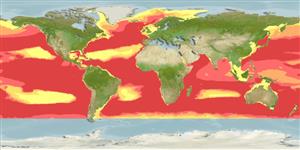>
Lophiiformes (Anglerfishes) >
Ceratiidae (Warty Seadevils)
Etymology: Cryptopsaras: Greek, kryptos =secret, hidden + Greek, psaras = fisherman (referring to this genus' tiny illicial bone, almost entirely covered by tissue of the esca) (Ref. 86949); couesii: Named for the eminent ornithologist Elliot Coues (Ref. 4525).
Eponymy: Dr Elliott Ladd Coues (pronounced ‘cows’) (1842–1899) was a US Army Surgeon who graduated from Columbia University (1861) then being appointed Assistant-Surgeon in the army (1864). [...] (Ref. 128868), visit book page.
More on author: Gill.
Environment: milieu / climate zone / depth range / distribution range
Ökologie
seewasser bathypelagisch; tiefenbereich 0 - 3085 m (Ref. 58018), usually 500 - 1250 m (Ref. 36494). Deep-water; 81°N - 52°S, 180°W - 180°E
Circumglobal: tropical and subtropical.
Size / Gewicht / Alter
Maturity: Lm ? range ? - ? cm
Max length : 7.3 cm TL Männchen/unbestimmt; (Ref. 4494); 44.0 cm TL (female)
Rückenflossenstacheln (insgesamt) : 1; Rückenflossenweichstrahlen (insgesamt) : 4 - 5; Afterflossenstacheln: 0; Afterflossenweichstrahlen: 4; Wirbelzahl: 20. A large median and two small lateral oval caruncles immediately in front of origin of dorsal fin (Ref. 13608). Branchiostegal rays: 6 (Ref. 36494).
Males dwarfed, becoming parasitic on females. Maximum size of free-living males is 1.05 cm (Ref. 4494). Females are oviparous, with planktonic larvae (Ref. 36494). Eggs are presumably contained in floating gelatinous rafts (Ref. 36494 ).
Females are oviparous, males are parasitic (Ref. 36494).
Bertelsen, E., 1990. Ceratiidae. p. 510-512. In J.C. Quero, J.C. Hureau, C. Karrer, A. Post and L. Saldanha (eds.) Check-list of the fishes of the eastern tropical Atlantic (CLOFETA). JNICT, Lisbon; SEI, Paris; and UNESCO, Paris. Vol. 1. (Ref. 4494)
IUCN Rote Liste Status (Ref. 130435: Version 2024-1)
Bedrohung für Menschen
Harmless
Nutzung durch Menschen
Fischereien: nicht kommerziell
Tools
Zusatzinformationen
Download XML
Internet Quellen
Estimates based on models
Preferred temperature (Ref.
123201): 2.8 - 10.4, mean 5.6 °C (based on 2308 cells).
Phylogenetic diversity index (Ref.
82804): PD
50 = 1.0625 [Uniqueness, from 0.5 = low to 2.0 = high].
Bayesian length-weight: a=0.01995 (0.00906 - 0.04395), b=3.01 (2.83 - 3.19), in cm total length, based on all LWR estimates for this body shape (Ref.
93245).
Trophic level (Ref.
69278): 4.5 ±0.37 se; based on food items.
Widerstandsfähigkeit (Ref.
120179): mittel, Verdopplung der Population dauert 1,4 - 4,4 Jahre. (tm=5).
Fishing Vulnerability (Ref.
59153): Low to moderate vulnerability (34 of 100).
Nutrients (Ref.
124155): Calcium = 58.6 [14.3, 144.7] mg/100g; Iron = 0.355 [0.143, 1.175] mg/100g; Protein = 18.2 [15.4, 21.6] %; Omega3 = 0.237 [0.062, 0.895] g/100g; Selenium = 11.6 [2.7, 41.2] μg/100g; VitaminA = 71.7 [6.1, 833.4] μg/100g; Zinc = 0.655 [0.299, 1.447] mg/100g (wet weight);
